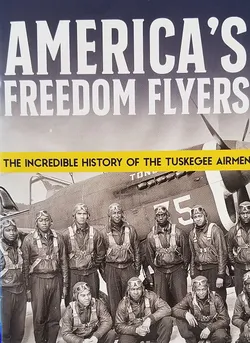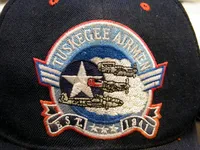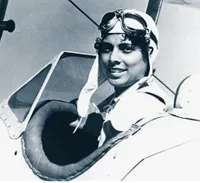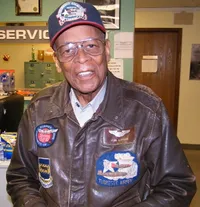
The Tuskegee Airmen[1] were famous for being the first African American military aviators in the United States armed forces. Flying during World War II as part of the Army Air Corps[2] (later the U.S. Army Air Forces) they dispelled widespread racial stereotypes. When speaking of the Tuskegee Airmen, most people only think of pilots, but the term included bombardiers, navigators, flight trainers and support personnel, all working together. A little-known fact is that women were also Tuskegee Airmen, serving in support roles rather than as combat pilots.
Trained at airfields in Tuskegee, Alabama, they became known for their exceptional skill and bravery in combat, flying approximately 1500 missions during WWII. The Tuskegee Airmen escorted bombers during critical missions, earning an outstanding reputation for their effectiveness and courage, while also significantly contributing to the eventual desegregation of the U.S. military.
Research your ancestors on MyHeritage
The Anticipation of WarThe Anticipation of War
Following the example of European countries who built up their air forces by training civilian pilots, America created The Civilian Pilot Training Program (CPTP)[3]. Authorized under President Franklin Delano Roosevelt[4] in December 1938, civilian pilots were trained through educational programs utilizing thirteen colleges. The whites-only program offered opportunities to those who never had them before.

In June 1941, FDR attempted to address segregation through Executive Order 8802[5], prohibiting racial discrimination in the defense industry. Though a step in the right direction, opening up jobs in the defense industry was just one of many changes needed. In July 1948, his successor, President Harry S. Truman[6] also attempted to address segregation through Executive Order 9981[7] by banning segregation in the armed forces. It established the President's Committee on Equality of Treatment and Opportunity in the Armed Services[8] to recommend revisions to military regulations in order to implement this policy.
The CPTP, under the oversight of The Civil Aeronautics Authority (CAA)[9] approved Tuskegee Institute[10] as a civilian private training school in October 1939. CAA’s deputy administrator Robert H. Hinckley[11] was the force behind (CPTP). By the following month, 16 candidates -14 men and 2 women, had physically qualified for training.
Eventually, six Black colleges, now part of today's Historically Black Colleges and Institutions (HCBUs)[12] took part in the Civilian Pilot Training Program. They were:
- Hampton Institute (now Hampton University)
- Howard University
- North Carolina A&T
- Delaware State College for Colored Students (now Delaware State University)
- Tuskegee Institute (Tuskegee University)
- West Virginia State College (now West Virginia State University)
Some Famous Tuskegee AirmenSome Famous Tuskegee Airmen
- Charles E. McGee[13]
- Benjamin O. Davis, Jr.[14]
- Mildred Hemmons Carter[15]
- Roscoe C. Brown, Jr.[16]
- Lee Archer[17]
- Daniel "Chappie" James, Jr.[18]

The Tuskegee Airmen are held in high esteem across the nation. Kentucky[19] is the first state to name a portion of their highway system for the Tuskegee Airmen. Colorado[20] and California[21] also have portions of their highway systems named for the dedicated men and women. A bust of Tuskegee Airman and Kentucky native Willa Brown Chappell[22], a female aviator who trained many Tuskegee Airmen pilots now resides in the Kentucky Historic Museum in Frankfort, Kentucky. She is the first Negro woman to receive a commission as a lieutenant in the U.S. Civil Air Patrol.
Highlighting Early PilotsHighlighting Early Pilots
Their LegacyTheir Legacy

The impact of the Tuskegee Airmen was not confined to their wartime achievements. By shattering racial stereotypes, their story demonstrated that the contributions of “ALL” Americans is key to our country’s survival and mental well-being. By their accomplishments they have motivated future generations to challenge discrimination and strive for equality. While overcoming racial discrimination and segregation, they became one of the most celebrated units in the U.S. Army Air Forces.
As fighter pilots, they excelled in their missions, notably escorting bombers to their targets with an impressive record of low losses. Their exceptional skills earned them the respect of their fellow servicemen and commanders, proving that courage and talent transcend racial barriers. The Red Tails, named for the distinctive paint on their aircraft tails, became a symbol of pride and determination.
Beyond their military success, the Tuskegee Airmen left a cultural and societal legacy that resonates today. Their bravery and determination are celebrated in books, films, and educational programs, serving as a powerful reminder of the strength of character in overcoming adversity. Some, lesser-known airmen, such as Lt Col. Alexander Jefferson[28] and Tuskegee Airman Flight Officer Daniel Keel[29] lived long lives and were able to share their story.
Explore more about the Tuskegee AirmenExplore more about the Tuskegee Airmen
- USA - Military records collection at MyHeritage
- African Americans in the Army: 1868-1948 webinar at Legacy Family Tree Webinars
- African American Genealogy Challenges: What You Need to Know! webinar at Legacy Family Tree Webinars
- Kraus, Theresa L. The CAA Helps America Prepare for World War II. Federal Aviation Administration, Accessed May 11, 2025.
- Alexander Jefferson, member of Tuskegee Airman, dies at 100. Fox 2 Detroit Staff.
- Millionard, Carl-Max. Greater Orlando Aviation Authority to Honor Tuskegee Airmen Hero with Distinguished Award. WFTV Orlando, May 21, 2025. Accessed June 1, 2025. MSN.
- Tuskegee Airmen. Britannica.com.
- Army Air Corps. History On The Net.
- Alabama: Tuskegee Institute National Historic Site. National Park Service.
- Haulman, Daniel L. The Tuskegee Airmen Chronology. A Detailed Timeline of the Red Tails and Other Black Pilots of World War II. New South Books. Montgomery, 2017.
- Greenly, Larry. Eugene Bullard: World’s First Black Fighter Pilot. Montgomery. New South Books. 2013. p69, 95-99.
- National Air and Space Museum. James Banning. Smithsonian.
- Martin, Captain Robert L. Red Tail: A Tuskegee Airman's Rendezvous with Destiny. iUniverse. February 2024.
References
- ↑ https://www.pbs.org/articles/who-are-the-tuskegee-airmen
- ↑ https://www.army.mil/aviation/
- ↑ The CAA Helps America Prepare for World War II. FAA
- ↑ Biography of Franklin D. Roosevelt, 32nd U.S. President
- ↑ https://www.eeoc.gov/history/executive-order-8802
- ↑ Harry S. Truman | Biography, Presidency, & Facts | Britannica
- ↑ Executive Order 9981: Desegregation of the Armed Forces (1948) | National Archives
- ↑ Records of the President's Committee on Equality of Treatment and Opportunity in the Armed Services (Record Group 220) | Harry S. Truman
- ↑ From Civil Aeronautics Authority (CAA) to FAA | Federal Aviation Administration
- ↑ Civilian Pilot Training Program - Tuskegee Airmen National Historic Site (U.S. National Park Service)
- ↑ From Civil Aeronautics Authority (CAA) to FAA | Federal Aviation Administration
- ↑ Historically Black Colleges: List of HBCUs - 2025 - MasterClass
- ↑ McGee_Charles_E_TA_Bio.pdf
- ↑ Benjamin O. Davis, Jr. | Biography & Facts | Britannica
- ↑ Mildred L. Hemmons-Carter | CAF RISE ABOVE
- ↑ Roscoe C. Brown, Jr. (1922-2016) | BlackPast.org
- ↑ Lee Archer (1919-2010) | BlackPast.org
- ↑ Daniel "Chappie" James, Jr. (1920-1978) | BlackPast.org
- ↑ https://nkaa.uky.edu/nkaa/items/show/1607
- ↑ https://www.codot.gov/news/2021/october-2021/i70-central-interstate-sign-dedication
- ↑ https://www.af.mil/News/Article-Display/Article/473373/road-to-the-past-portion-of-highway-dedicated-to-tuskegee-airmen/
- ↑ https://www.blackpast.org/african-american-history/brown-willa-b-1906-1992/
- ↑ The Two Lives of Eugene Bullard | American Experience | Official Site | PBS
- ↑ Biography: Bessie Coleman
- ↑ John C. Robinson, Aviator born - African American Registry
- ↑ Crossing the Country with James H. Banning | National Air and Space Museum
- ↑ Thomas C. Allen, Aviator born - African American Registry
- ↑ Alexander Jefferson | The National WWII Museum | New Orleans
- ↑ Greater Orlando Aviation Authority to honor Tuskegee Airmen hero with distinguished award


